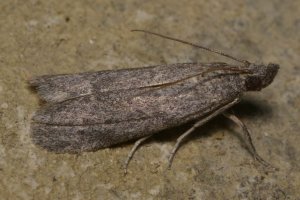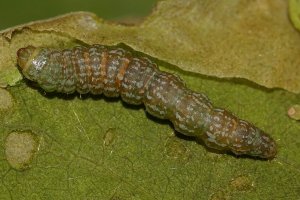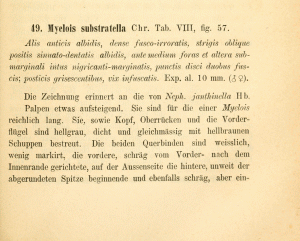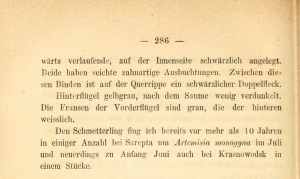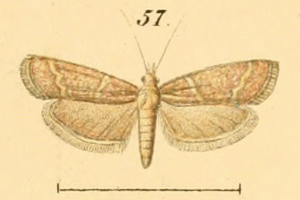1. Lebendfotos
1.1. Falter
1.2. Raupe
2. Diagnose
2.1. Erstbeschreibung
3. Biologie
3.1. Nahrung der Raupe
- [Plumbaginaceae:] Limonium scoparium
Die Nahrung der Raupe dieser Art war lange unbekannt. Bidzilya et al. (2019: 455) können dann aber ausführlich berichten: "Since 1999 the larvae were regularly observed in halophilic plant associations (salt-marshes, halophilic steppes, coastal plant communities) all over the Crimea—Sevastopol, vicinity of Saki and Yevpatoria, Meganom, Lysiacha Bukhta, Karadag, Barakol Lake, Tycha Bukhta, Dvoiakirna Bukhta, the vicinity of Prymorskyi, Yasnopolyanske and Lvovo villages, Arabatskay Strilka, Mysove, Kazantyp, Karalar steppe (Fig. 79). The larvae feed on Limonium scoparium (Pall. ex Willd.) Stank. from mid June to late July and then from late August to October. Both first instars and adult larvae live usually singly or by 2–3 individuals in large spotted mines on leaves of the host plant (see Savchuk 2019). When taken out of mine the larvae can not penitrate in the leaf again and dying. Pupation occurs out of the feeding place in plant debris in a grey cocoon or within the mine. The mature larva most likely overwinters in debris before pupation." Fraglich ist, ob die Art überall im Verbreitungsgebiet ausschließlich Limonium scoparium nutzt oder auch an weiteren Strandflieder-Arten leben kann.
4. Weitere Informationen
4.1. Andere Kombinationen
- Myelois substratella Christoph, 1877 [Originalkombination]
- Ancylosoma substratella (Christoph, 1877) [bis Bidzilya et al. (2019) übliche Kombination]
4.2. Andere Schreibweisen
- Ancylosis substratellum [nach dem Gender Agreement des ICZN korrekte Schreibweise für Ancylosis substratella]
- Ancylosoma substratellum [nach dem Gender Agreement des ICZN korrekte Schreibweise für Ancylosoma substratella]
4.3. Taxonomie
Die Art wurde bisher meist in einer eigenen Gattung Ancylosoma geführt. Bidzilya et al. (2019) kommen zum Ergebnis: "The study of Ancylosoma substratellum justified that monotypic genus Ancylosoma Roesler, 1973 matches the diagnosis of Ancylosis Zeller, 1839 in the most important diagnostic characters and should be synonymized with the latter." Sie führen die Art daher unter "Ancylosis substratellum (Christoph, 1877) comb. n."
4.4. Faunistik
Bidzilya et al. (2019) aktualisieren den Kenntnisstand dieser in Europa auf die Krim, den Süden Russlands und West-Kasachstan beschränkten Art: "Russia (Lower Volga, Caucasus, Southern Ural), West Kazakhstan (Uralsk), Turkmenistan (Roesler 1973; Sinev 2008), Transcaucasus, Iran (Sinev 1986), Turkey (new record). In Ukraine the species is known from Crimea (Bidzilya & Budashkin 2004: 66) and Zaporizhzhia region (Bidzilya et al. 2011: 70)."
(Autor: Erwin Rennwald)
4.5. Publikationsjahr der Erstbeschreibung
Datierung nach der « Répartition des livraisons » auf der dem Inhaltsverzeichnis des Bandes folgenden Seite.
4.6. Literatur
- Bidzilya, O., Budashkin, Y. & V. Yepishin (2019): A review of the genus Ancylosis Zeller, 1839 (Lepidoptera: Pyralidae: Phycitinae) from Ukraine. — Zootaxa 4657 (3): 437–473.
- Erstbeschreibung: Christoph (1876-1877): Sammelergebnisse aus Nordpersien, Krasnowodsk in Turkmenien und dem Daghestan. — Horae societatis entomologicae rossicae 12: 181-299, pl. VI-VIII. St. Pétersbourg (V. Bésobrasoff & Comp.).




![Vorkommen in Russland (europäischer Teil bis Manytsch-Niederung) [Sinev (2021)]](/res/img/flag/ru.gif)
![Vorkommen auf der Krim [Sinev (2021)]](/res/img/flag/ua-kri.gif)
![Vorkommen in Rumänien [Rákosy L. & M. Goia (2021): Lepidopterle din România: lista sistematică şi distribuţie]](/res/img/flag/ro.gif)
